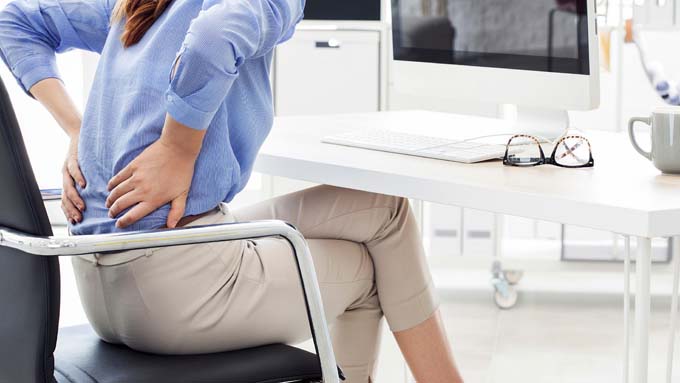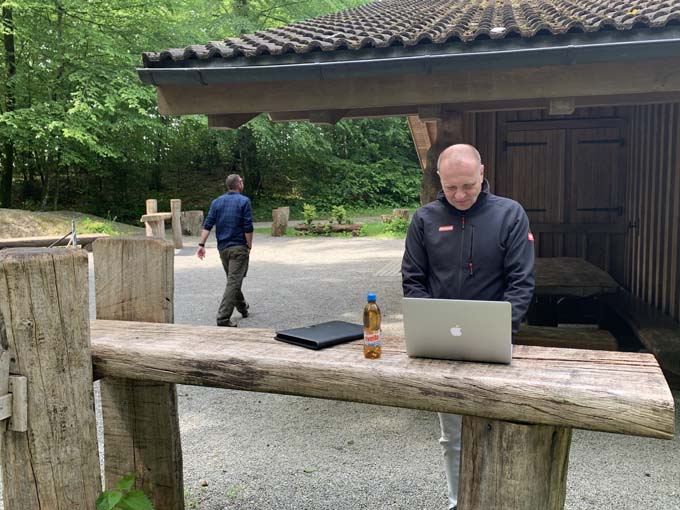Back pain: The cross with the cross
Many working people spend most of their working time sitting down. Be it at a PC or on the phone, talking to customers or in internal company meetings. Back problems are therefore inevitable.

Alongside mental illness, back problems are the number one widespread disease. According to various statistics, more than 80 percent of all employees over the age of 40 have been temporarily unable to move due to the infamous lumbago. In Germany, for example, one in twenty people will undergo surgery for a back problem in the course of their lives. In addition, around half of all early retirements in Germany are due to spinal problems, among other things.
Cause of back pain: poor posture and one-sided physical strain
These figures are consistent with the findings in my practice. More than half of my clients complain during their first visit that they have back pain more or less regularly. This is usually not due to organic causes. Rather, the cause lies in poor posture and one-sided physical strain. There are also psychological factors such as stress. This can also cause pain-inducing tension.
In terms of evolutionary history, the cause of "our cross with the cross" lies many millions of years ago. At that time, humans learned to walk upright. It enabled our ancestors to use their hands freely and to make and use tools. At the same time, however, it led to greater strain on the spine as well as the hip and knee joints. As a result, humans have been carrying the health problem of back pain around with them for millions of years.
There are many reasons why this occurs more frequently in our society. One of the main reasons is our longer lifespan. This increases the likelihood that our musculoskeletal system will show signs of wear and tear.
The load on the spine has changed
What's more, our physical strain is different today than it was 100 years ago. On the one hand, when we sit for hours on end typing texts into a PC or laptop, for example, our spine is under constant strain from which it can rarely relax, and on the other hand, we only use a few muscle groups. In the long term, this leads to certain muscle groups regressing or shortening. They then no longer provide our spine with sufficient support. The result is painful tension, e.g. in the neck (cervical vertebra syndrome) or in the lumbar vertebrae (lumbar vertebra syndrome).
The so-called intervertebral discs play an important role here. They form a kind of buffer between the individual vertebrae. They prevent the individual bones from rubbing against each other and thus wearing out. Frequent incorrect loading can overstress the intervertebral discs and restrict their buffering function. The result: the dreaded slipped disc.
You can avoid back pain through prevention
Such problems can be prevented. The least strain is placed on the intervertebral discs when lying down. Even when sitting and standing (assuming a straight sitting/standing posture), the intervertebral discs are only slightly stressed. Here are two examples: A sitting posture with the upper body slightly bent forward puts twice as much strain on the intervertebral disc as a "disc-friendly" straight posture. The strain on the intervertebral disc when standing with the upper body bent forward is more than 50 percent higher than with a straight standing posture. Lifting "incorrectly" with a bent spine also puts a lot of strain on the intervertebral discs. The correct approach is to bend your knees when lifting and keep your back in a straight position.
Strong hip, thigh, back, chest and abdominal muscles give the spine the support it needs. Office workers in particular should therefore make sure they get some exercise after work and at the weekend. In addition to special strength and stretching exercises related to these muscle groups, such as those often practiced in yoga, sports such as swimming, jogging, cycling or hiking are particularly suitable for compensating for work-related lack of exercise. In addition to building muscle, these endurance sports have other health-promoting effects. Regular exercise prevents cardiovascular disease, helps to reduce stress and promotes healthy, restful sleep.
Tips for everyday professional and working life
But what can you do if you experience back problems during everyday office work? Then you should first check whether your desk and chair are at an appropriate height for your height and whether your monitor is positioned so that you can look at the screen without straining. If you still have problems afterwards, stretching exercises, which you can also do at your desk, can help. It usually helps to stand up for a few minutes, walk around and stretch to relieve the tension. If possible, you should change your sitting position several times a day, for example by swapping your desk chair for a sitting ball. Or: simply shorten the long periods of sitting at your desk by doing certain tasks at a standing desk.
And another tip: if possible, make your calls while standing and walking back and forth in your office. No problem with portable phones today.
About the author:
Anja Botter is a non-medical practitioner for psychotherapy and a yoga teacher. She runs a yoga studio in Welle in der Nordheide, where she offers yoga classes and personal training, among other things; she also has a psychotherapy practice for psychological counseling (www.bewegte-leichtigkeit.de).
Prevent back pain
Back pain is one of the most common complaints of office workers. 10 tips on how to avoid them.
- Ergonomic sitting posture: Adjust your chair so that your feet are flat on the floor and your knees are at a 90-degree angle. The backrest should support your back and your arms should rest at a right angle on the table top.
- Height-adjustable desk: A height-adjustable desk allows you to switch between sitting and standing. This change relieves strain on the back and promotes circulation.
- Adjust screen height: Position the monitor so that the top line of the screen is at eye level. This prevents you from tilting your head downwards and straining your neck and back muscles.
- Take regular breaks: Take a break of about 5 minutes every hour. Use this time to stand up, stretch or take a few steps.
- Use alternative seating: An exercise ball or an ergonomic stool can be temporary alternatives to sitting. They promote an active sitting posture that strengthens the back muscles.
- Strengthen the back muscles: Strengthen your core muscles with exercises such as trunk flexion. Just 10 minutes of exercise a day will make a big difference.
- Conscious breathing: Incorrect breathing can also cause tension. Breathe deeply into your stomach instead of shallowly into your chest. This improves the oxygen supply to your muscles.
- Drink plenty of water: Dehydration can also lead to muscle tension and back pain. Drink enough water throughout the day - about two or three liters.
- Relaxation and stretching exercises: Do daily stretching and relaxation exercises (e.g. yoga or progressive muscle relaxation). This increases your flexibility and reduces tension.
- Consciously dealing with stress: Constant stress also often causes back problems. Identify the stress factors and develop strategies for coping with stress. Meditation and breathing exercises help you to relax physically and mentally.
Anja Botter
Editor's note: Further tips and exercises for "frequent sitters" are also available from Suva, namely here.









